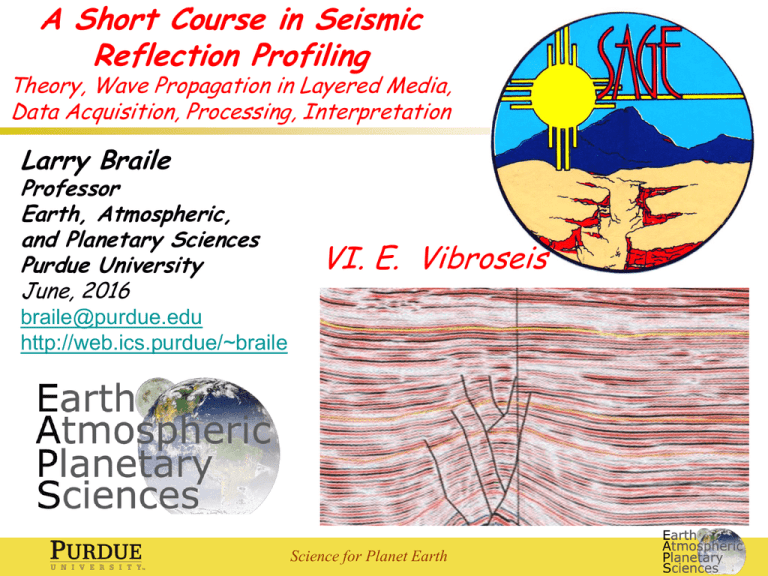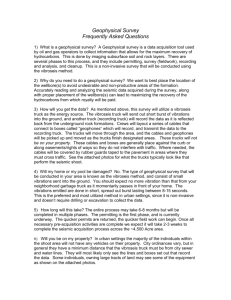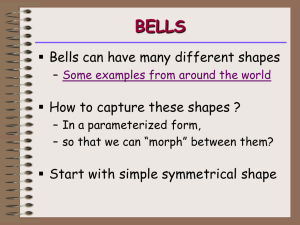A Short Course in Seismic Reflection Profiling VI. E. Vibroseis
advertisement

A Short Course in Seismic Reflection Profiling Theory, Wave Propagation in Layered Media, Data Acquisition, Processing, Interpretation Larry Braile Professor Earth, Atmospheric, and Planetary Sciences Purdue University June, 2016 VI. E. Vibroseis braile@purdue.edu http://web.ics.purdue/~braile Science for Planet Earth A Short Course in Seismic Reflection Profiling Theory, Wave Propagation in Layered Media, Data Acquisition, Processing, Interpretation Prof. L. W. Braile Table of Contents I. II. III. IV. V. VI. Introduction Theory Rock Properties Some Definitions Seismic Data Acquisition Seismic Data Processing Understanding Vibroseis Correlation VII. Reflection Profiling Interpretation – General Principles VIII. A Brief Look at Interpretation IX. A Few Useful References Science for Planet Earth VI. Seismic Data Processing E. Vibroseis Correlation – An Example of Digital Signal Processing Vibroseis Correlation – An Example of Digital Signal Processing Larry Braile Department of Earth, Atmospheric, and Planetary Sciences Purdue University West Lafayette, IN 47907 braile@purdue.edu http://web.ics.purdue.edu/~braile URL for this file: http://web.ics.purdue.edu/~braile/sage/ShortCourseNotes.6.A.Vibroseis.pdf URL for PPT: http://web.ics.purdue.edu/~braile/sage/ShortCourseNotes.6.A.Vibroseis.ppt Understanding Vibroseis Correlation – Significance and Audience An example of digital signal processing and linear systems representation of seismograms. Vibroseis is an important and commonly used method for seismic reflection data acquisition. Most useful at the advanced undergraduate and graduate level (most effective for students with a basic understanding of convolution and Fourier transforms). Understanding Vibroseis Correlation – Fundamental Concepts Illustrate time and frequency domain content of signals. Example of time and frequency domain representation and signal processing. Illustration of amplitude and phase representation of the Fourier transform. Applications of the convolution theorem. Demonstration of the meaning of the phase spectrum. Explains why the arrival time is at the center of the wavelet for Vibroseis seismograms. Explains how cross-correlation with the sweep collapses the sweep reflections into wavelets. Illustrate windowing, smoothing and effect of truncation concepts. A Sample Vibroseis Sweep The sample Vibroseis sweep (above) has relatively low frequencies and a limited frequency range so that the signals can be easily viewed in the following illustrations. Typical exploration seismology Vibroseis sweeps are in the range of ~8 to 80 Hz. The sample Vibroseis sweep has sinusoidal character and begins with a frequency of 1 Hz and ends with a frequency of 5 Hz. Effect of Windowing The input sweep is commonly “windowed” (tapered at the ends as shown above) to reduce mechanical problems associated with coupling of the Vibroseis “pad” to the ground at the beginning and end of the sweep input, and to reduce truncation effects (Gibbs phenomena) that produce sidelobes and a longer duration wavelet. Vibroseis Schematic – Figure 1 (next slide and small image below) is a schematic illustration of how Vibroseis works. The data were calculated and plotted with a MATLAB code. The first trace (red) is the sample sweep after applying a window to smoothly taper the sweep at the beginning and end. The second trace (blue) is an Earth vertical incidence reflection response from three interfaces. The resulting response has three spikes (impulses) representing reflection coefficients. The spikes are located at the two-way travel times and are scaled in amplitude by the reflection coefficient. Note that spikes 1 and 3 are positive amplitude impulses and spike 2 is a negative amplitude impulse. The next three traces (black) are the reflection responses to the downward traveling source sweep. They are aligned in time by the reflection travel times and are scaled by the spike amplitude (reflection coefficient). Note that the response for reflection 2 is phase reversed. Vibroseis Schematic (continued) – The sixth trace is the recorded seismogram (green, uncorrelated) and can be produced by summing the three reflection responses (black) or, equivalently, by convolving the source sweep (red) with the Earth response (blue). When Vibroseis data are collected and recorded from the geophones, the data initially look similar to the uncorrelated seismogram shown in green. Note that the trace is long (in this case 16 s) compared to the maximum two-way travel time of the target Earth model (in this case 7 seconds), and is very “ringy” (sinusoidal character). The difference between the total recording time and the sweep length is the “listen time.” The “trick” to Vibroseis is to cross-correlate the sweep with the uncorrelated seismogram. This process collapses the sweeps into wavelets and reduces the length of the seismogram. The resulting seismogram is shown in the bottom trace (red). Figure 1. Vibroseis Schematic (explanation on previous slides) After Lindseth, 1968 Figure 1. Vibroseis Schematic (explanation on previous slides) = With Sweep = After Lindseth, 1968 Figure 2. Vibroseis Schematic – Cross-Correlation Illustration of the cross-correlation process – position of one time lag of the pilot sweep (red) is shown below (on top of the green trace; all time lags are calculated as the pilot sweep moves from left to right over the uncorrelated seismogram; also see video and animation in PowerPoint referenced below). At this position, the cross-correlation coefficient (the sum of the product of the two signals) is a maximum (the product of two positive parts of the signals is positive, and the product of two negative parts of the signals is also positive) and is plotted on the bottom red trace (the seismogram, s(t)) at the lag position shown by the thin vertical line. Note that the wavelet that is produced is symmetric and is centered on the two-way travel time for the reflections (1.5, 3.5 and 7 s). The wavelets contain the sweep frequencies (1 to 5 Hz energy). After Lindseth, 1968 Correlation coefficient is calculated at each time sample () to form seismogram Figure 1. Vibroseis Schematic – Cross Correlation with pilot Coefficient plotted at location of thin black line () Crosscorrelation: shift, multiply and sum; repeat After Lindseth, 1968 Figure 1. Vibroseis Schematic – Cross Correlation, 1st Reflection Coefficient plotted at location of thin black line Arrival Time Maximum positive correlation at this position After Lindseth, 1968 Figure 1. Vibroseis Schematic – Cross Correlation, 2nd Reflection Coefficient plotted at location of thin black line Arrival Time Maximum negative correlation at this position After Lindseth, 1968 Figure 1. Vibroseis Schematic – Cross Correlation, 3rd Reflection Coefficient plotted at location of thin black line Arrival Time Maximum positive correlation at this position After Lindseth, 1968 Time and frequency domain representation of Vibroseis data acquisition and correlation processing: In the next two slides (small view of the first slide shown below), the vibroseis process is illustrated in both the time and frequency domain. The three columns illustrate the time domain (red), frequency domain amplitude spectrum (blue), and frequency domain phase spectrum (green) for each step (rows) of the process. Figure 3a (1st row) shows the pilot sweep in time and the amplitude and phase spectra. Note that the amplitude spectrum shows that the sweep contains energy from about 1 to 5 Hz and the “edges” of the spectrum are smooth due to the taper applied to the sweep. The slope of the phase spectrum is the delay of the frequencies showing that the low frequencies are delayed a small amount and the higher frequencies are increasingly delayed. Time and frequency domain representation of Vibroseis data acquisition and correlation processing (continued): Figure 3b (2nd row) shows the time and frequency plots for the Earth response (reflections). Note that the phase spectrum has constant slope as the spikes contain all frequencies and each spike is delayed in time. Figure 3c (3rd row) is the result of convolution (in the time domain) of the sweep and the Earth response which produces the uncorrelated seismogram shown in the lower left. The equivalent process in the frequency domain is multiplication (the convolution theorem), which, for amplitude and phase spectra means multiplying the amplitude spectra and adding the phase spectra. Note that the phase spectrum of the uncorrelated seismogram (lower right) is curved but not equal to the phase spectrum of the sweep. Time and frequency domain representation of Vibroseis data acquisition and correlation processing (continued): Figure 3d (1st row) shows the time and frequency plots for the Earth uncorrelated seismogram, identical to Figure 3c. To process the uncorrelated seismogram, we cross-correlate with the sweep (shown in Figure 3e, 2nd row). Note that in the frequency domain, cross-correlation is the same as multiplying with the conjugate of the spectra (a corollary of the convolution theorem) which means multiplying the amplitude spectra and adding the negative of one of the phase spectrum to the other phase spectrum. In this process, the phase spectrum of the sweep (and associated delays in the time domain) disappears and we are left with the phase spectrum of the Earth response. The result is shown in Figure 3f (3rd row). Time and frequency domain signals: sw(t) SW(f) e(t) E(f) u(t) U(f) s(t) S(f) Vibroseis Sweep Earth Response (spike series) Uncorrelated Seismogram (sweeps) Correlated Seismogram (wavelets) Operator Symbols: Multiplication Convolution Correlation Has Fourier Transform || Equals (above and below) The following plots (sub-figures) are related both horizontally and vertically. Figure 3a,b,c. Uncorrelated Seismogram – Time and Frequency + || || || Figure 3d,e,f. Correlated Seismogram – Time and Frequency + (conjugate) || || || Theory and Derivation Illustrated by Figure 1 Schematically illustrated in the time domain in Figure 2 Illustrated by Figure 3a,b,c ) Illustrated by Figure 3d,e,f Illustrated by Figure 3f The following two slides are Figure 3a,b,c and Figure 3d,e,f in expanded view. Figure 3a,b,c. Uncorrelated Seismogram – Time and Frequency + || || || Figure 3d,e,f. Correlated Seismogram – Time and Frequency + (conjugate) || || || The Vibroseis Method: The Vibroseis method has a number of advantages related to the truck mounted source and long sweep (many seconds). Substantial energy can be put into the ground with the long sweep, multiple sources (trucks), and repeated sweeps (stacked). The Vibroseis sweep can be designed and controlled, and it is a mobile and repeatable source. Because the energy is distributed over time, environmental effects are reduced. Cross-correlation is a powerful signal recognition process so Vibroseis can be used in relatively noisy environments. Unlike explosive sources, if a source location (often called a VP) needs to be recorded a second or third time, it is relatively easy to repeat the VP. Disadvantages are: the Vibroseis method may require substantial equipment and cost for large offset surveys and sometimes produces large surface waves that are difficult to remove from the record section. Vibroseis PowerPoint Presentation Vibroseis courtesy of ION Geophysical A PowerPoint presentation including some of the figures shown here, an animation of the Vibroseis correlation process, and videos of a Vibroseis truck in action, is available at: http://web.ics.purdue.edu/~braile/sage/SAGE2008Vibroseis.ppt Download the .ppt file (3.4MB) and the five videos (.wmv files) and place them in the same folder on your computer. http://web.ics.purdue.edu/~braile/sage/vid00001.wmv (18.9MB) http://web.ics.purdue.edu/~braile/sage/vid00014.wmv (40.2MB) http://web.ics.purdue.edu/~braile/sage/vid00011.wmv (17.7MB) http://web.ics.purdue.edu/~braile/sage/vid00013.wmv (14.3MB) http://web.ics.purdue.edu/~braile/sage/vid00009.wmv (19.3MB) Example of Vibroseis correlation. First two traces on the left – Sweep (6-60 Hz); numbers to right are time in seconds. Next three record sections – Uncorrelated seismograms; record length (sweep length plus “listen time”) = 15 s. Last record on right – Correlated seismograms (5 s); note prominent seismic signals including hyperbolic curved reflections. From Yilmaz, 2001. References Anstey, Nigel A., Introduction to Vibroseis, 1961. Anstey, Nigel A., Vibroseis, Prentice Hall, 1991. Lindseth, Roy O., Digital Processing of Geophysical Data — A Review, originally published 1968, SEG Course Notes, 1982, 282 pages, Catalog #251A, available at: http://library.seg.org/doi/book/10.1190/1.9781560802310 http://library.seg.org/doi/abs/10.1190/1.9781560802310.ch7 (Vibroseis). Yilmaz, O., Seismic Data Processing, SEG, Investigations in Geophysics, No. 2, Tulsa, 526 p., 1987. Yilmaz, O., Seismic Data Analysis (vol. 1 & 2), Soc. Explor. Geophys., Tulsa, Volume I, p. 1-1000; Volume II, p. 1001-2027, 2001. (http://library.seg.org/doi/abs/10.1190/1.9781560801580.fm). References From Lindseth, 1968: The Matlab code and Figure 1 (above ; and related Figures) were inspired by the schematic illustration from Lindseth (below). http://wiki.seg.org/index.php/Dictionary:Fig_V-12 From Lindseth, 1968: “This uncomplicated model responds well to relatively simple treatment. Crosscorrelation has been mentioned as a good method to extract a known signal from noise. The conventional method used by data processors to extract the earth signal from the recorded signal is to crosscorrelate the sweep with the recorded signal. The process is done before applying NMO. Crosscorrelation of the sweep with the record has an effect upon the phase exactly opposite to that of convolution, cancelling completely the phase shift which occurred in the original convolution. In simple terms, the original product of the field operation is: Ae ( earth ) • As ( sweep ); Øe + Øs (Amplitude and Phase) Crosscorrelation of the recorded signal with the same input sweep signal produces: ( Ae • As ) • As ; ( Øe + Øs) - Øs (Amplitude and Phase) Consolidating and cancelling out terms, the result of the crosscorrelation becomes simply: Ae • As 2 ; Øe (Amplitude and Phase) All the influence of the phase of the sweep upon the phase of the field record has been eliminated, leaving the individual reflection components of the processed record with the phase of the original earth signal. Each recorded reflection coefficient should now be recognizable as the best approximation of a spike possible with the range of frequencies contained in the sweep signal. This is exactly the effect which we wish to obtain with wavelet deconvolution and which is so difficult to achieve on signals from conventional seismic signal generators. The amplitude of the output is weighted by the product of the amplitude spectrum of the sweep, but, since the sweep spectrum is completely white, the squared spectrum is also white, which merely multiplies the earth spectrum by a constant, which is not serious.”


